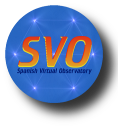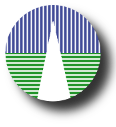 |
 |
Configuration
Search OptionsBy default the 'Data Retrieval' section of the web page would include a simple Cone Search form where users could search for catalogue entries around a given point in the sky (RA and DEC) and within a search radius (SR). But if your catalogue does not include RA,DEC coordinates, this type of Cone Search queries do not make sense, and this search form will not be shown. Instead, you have the option to configure your service so that users can restrict searches using other catalogue fields. For each field you can set the 'Search' column to "Yes" and it will be optionally allowed for searches. If you mark a field as "Yes", you must also set the "Search type" and "Form Type" to specify how this field shoud be used.
You must set this configuration values wisely. For instance:
In our case we have allowed to restrict searches using 'descrip', 'lmean' and 'weff' and we have allowed ranges for both 'lmean' and 'weff'. Now the search form will show the corresponding entries for these two fields:
of course, if the user does not set any restriction on them, the search results won't be affected. In this case, there are 42 catalogue entries that are shown as default. But users can restrict the results to those with a λmean between 3550 and 4000 Angstroms (just an example): you can see that the list of results has changed. Now there are only 5 filters that meet the condition. But users can also restrict the query asking for results which description contains the string 'colors' (using % as wildcard): and now 14 catalogue entries match the restriction. Just as an example, if we had set 'Form type'='select' for the 'λmean' field the web form would have been different, showing a select box for minimum and maximum λmean values. where a user could have seen a list of all values for λmean present in the catalogue and choose among them (both for the minimum and maximum of the range). I don't think that this makes sense when the list of posible values is very long, and it is not usually a good choice for double type fields, but of course it's your decision. Mags/Colors searchIn the case that your catalogue contains photometry values, an special form can be included to search for magnitude and colors ranges. It does not apply in the case of our example catalogue. So we leave it empty. Object Name/Target searchIn the case that your catalogue contains astronomical objects you could want to configure special options to allow for alternative object names using Simbad information. In our example catalogue this does not apply and we leave this form empty. Default searchWhen a user first accesses the 'Data retrieval' section it is usual to show, at least, a part of the catalogue by default. This means performing a "Default search" and showing the results of this search. You can configure here if you want to show the catalogue as default, how many results you want to show and if you want to add some restrictions to the default search. In our example catalogue we have choosen to show all the results sort by the λmean value (oby=lmean). But you can include more restrictions. For instance, you can ask to show only entries with λmean in a given range: and the default result would include that restriction: Other search optionsIn this section you need to allow to make searches without using RA,DEC coordinates. This is necessary for catalogues that do not contain RA,DEC. Special listingsIn the search page you can specify some special listings for catalogue entries with certain properties. These will appear as links so that, when the user clicks on of them, a search will be done and the corresponding results will be shown. To do this you must specify the text that will appear highlighted and the restrictions in terms of the database fields (only for database fields that have been configured above as available for search, that is: descip, lmean or weff in our case). In our example catalogue this does not make much sense because it is very small. But we could, for instance, define some links as: The first one would produce a list of filters that contain 'Bessell' in the description (note the % wildcards). The second one would produce a list of filters with an "effective width" smaller than 300A. Search options in ConeSearchAlthough the VO ConeSearch protocol only specifies that RA/DEC/SR must be the search criteria, it does not forbid to restrict searches using other catalogue fields. In our particular implementation of ConeSearch all the search restrictions that are allowed for the web page are also allowed for the ConeSearch queries. In order to make these options public, we have implemented a 'format=metadata' option in the same way as it is specified in the SSA protocol: http://www.mylab.org/catalogues/exfilters/cs.php?format=metadata (where, remember, http://www.mylab.org/catalogues/exfilters/ should be the main URL that corresponds to your installation) There, among other things, the list of parameters allowed for queries are specified in the usual fashion (and the available range or list of posible values when appropiate).
so that valid queries to the catalogue ConeSearch service could be, for instance:
depending on how the user wants to restrict the query. (note that the % wildcards must be urlencoded as %25 when included in urls). |